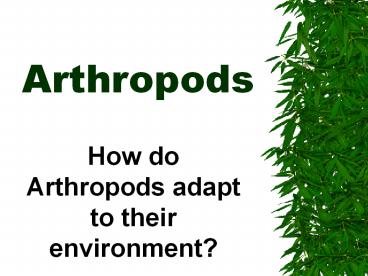Arthropods - PowerPoint PPT Presentation
Title:
Arthropods
Description:
Arthropods How do Arthropods adapt to their environment? ... The shedding of the exoskeleton. Major classes Arachnids (spiders, scorpions, ticks, and mites) ... – PowerPoint PPT presentation
Number of Views:278
Avg rating:3.0/5.0
Title: Arthropods
1
Arthropods
- How do Arthropods adapt to their environment?
2
Arthropods
- What does Arthropod mean?
3
Arthropods
- What does Arthropod mean?
- Jointed foot
4
Characteristics
- Jointed appendages
5
Characteristics
- Jointed appendages
- Exoskeleton (external skeleton)
6
Characteristics
- Jointed appendages
- Exoskeleton (external skeleton)
- Segmented body
7
Characteristics
- Jointed appendages
- Exoskeleton (external skeleton)
- Segmented body
- Open circulatory system
8
Characteristics
- Types of appendages
9
Characteristics
- Types of appendages
- Claws / pincers
10
Characteristics
- Types of appendages
- Claws / pincers
- Antennae
11
Characteristics
- Types of appendages
- Claws / pincers
- Antennae
- legs
12
Characteristics
- Types of appendages
- Claws / pincers
- Antennae
- Legs
- wings
13
Characteristics
- How does the exoskeleton help it survive?
14
Characteristics
- How does the exoskeleton help it survive?
- Keeps moisture inside the animal.
15
Characteristics
- How does the exoskeleton help it survive?
- Keeps moisture inside the animal.
- Protects the animal
16
Characteristics
- What is molting?
17
Characteristics
- What is molting?
- The shedding of the exoskeleton.
18
Major classes
- Arachnids (spiders, scorpions, ticks, and mites)
19
Major classes
- Arachnids (spiders, scorpions, ticks, and mites)
- Diplopods (millipedes)
20
Major classes
- Arachnids (spiders, scorpions, ticks, and mites)
- Diplopods (millipedes)
- Chilopods (centipedes)
21
Major classes
- Arachnids (spiders, scorpions, ticks, and mites)
- Diplopods (millipedes)
- Chilopods (centipedes)
- Insects
22
Major classes
- Arachnids (spiders, scorpions, ticks, and mites)
- Diplopods (millipedes)
- Chilopods (centipedes)
- Insects
- Crustaceans (crabs, lobsters, crayfish, and
shrimp)
23
Characteristics
- How do Arthropods develop into adults?
- Metamorphosis
- Complete metamorphosis stages - egg, larva,
pupa, adult
24
Characteristics
- How do Arthropods develop into adults?
- Metamorphosis
- Complete metamorphosis stages - egg, larva,
pupa, adult - Incomplete metamorphosis stages egg, nymph,
adult
25
(No Transcript)
26
(No Transcript)
27
(No Transcript)
28
(No Transcript)
29
(No Transcript)
30
(No Transcript)
31
(No Transcript)
32
(No Transcript)
33
(No Transcript)
34
(No Transcript)
35
(No Transcript)
36
(No Transcript)
37
(No Transcript)
38
(No Transcript)
39
(No Transcript)
40
(No Transcript)































